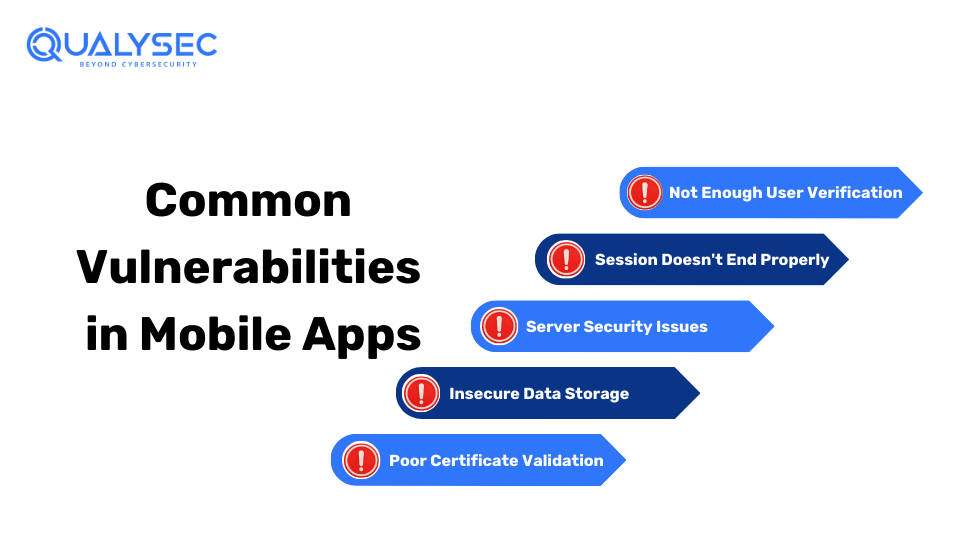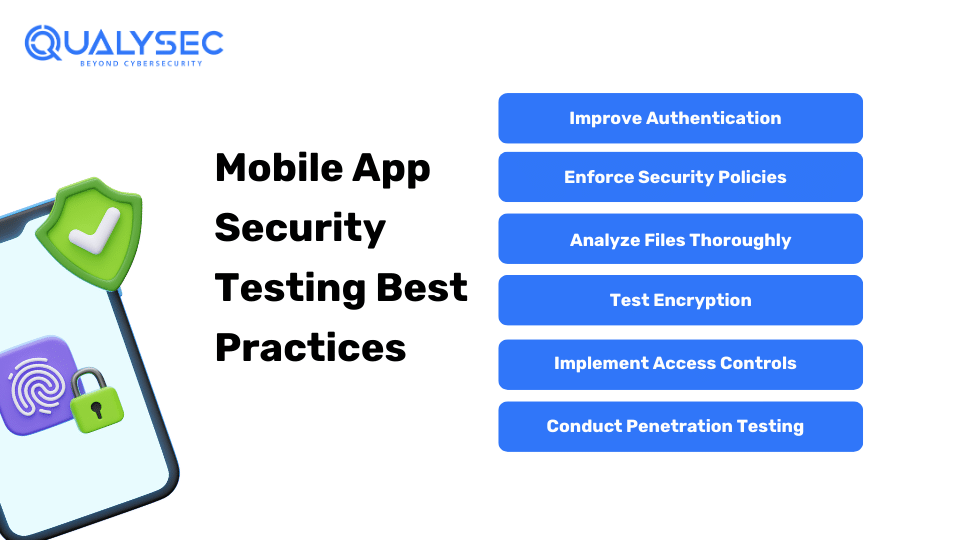© 2024 Qualysec.com Disclaimer Privacy Policy Terms & Conditions

To make an app more secure, developers must make sure their apps can pass tough security tests. Luckily, some technologies can make these security tests easier and even automatic. Following best practices can also help guide and teach the testing process. This blog talks about the most common mobile app security testing and points out popular vulnerabilities. We’ll also go over recommended practices for app security testing and tools for keeping mobile apps safe in a CI/CD pipeline.
Thorough penetration testing can prevent or reduce mobile app security errors (or breaches). Hence, to keep mobile apps secure, developers and businesses are doing penetration testing. This means carefully checking the IT systems, database security, the mobile apps themselves, and any other parts that make up the app.
Following best practices for mobile app security is seen as an important part of the overall app security plan. If a company doesn’t have people with penetration testing skills for mobile apps, it is highly recommended to work with a good penetration testing company. The next paragraphs will explain the basic steps for developing an effective way to do penetration testing on mobile apps.
Mobile app security keeps valuable mobile apps and your online identity safe from cyber attacks. This includes things like keyloggers, malware, tampering, reverse engineering, and other interference or changes. A complete mobile app security plan includes best practices for use and company procedures, along with tech solutions like mobile app shielding.
Mobile app security has become more important as mobile devices are used more in many countries and areas. More mobile devices, apps, and users means more people using mobile for banking, shopping, and other activities. The good news is banks are making their security stronger for customers using mobile devices for financial services with Android and iOS application penetration testing.
Mobile app security is really important because of how much sensitive data is stored on mobile devices and how much we rely on them. Organizations and users can protect their mobile apps in advance by being aware of common threats and weaknesses.

Some common dangers and weaknesses of mobile apps are:
This happens when an app doesn’t properly check that the user is allowed to do an action or access data based on the security rules. User verification processes should watch what a user, service, or app is permitted to do.
User identifiers become invalid when a user logs out of the app. However other users may still act on behalf of those users if the server can’t properly invalidate those identifiers. You must ensure the app has a logout button and waits until the session is correctly ended.
Preventing unauthorized access can be done on the server side, but input checks and limits must be built into the app to reduce load on the server. The app should verify input data during server processing and stop bad behavior.
Storing sensitive data insecurely on the device can cause vulnerabilities. Sensitive data stored on devices can potentially be stolen. Apps should store sensitive data in secure keychains. Data encryption is needed if stored on the device.
Mobile apps need to properly validate SSL/TLS certificates or refuse the connection if it can’t validate them. If not validated properly, data could be accessed illegally. Certificate validation must be done correctly to ensure certificates are from a trusted source.
Want to see what an actual mobile app security testing looks like? Just click the link below and download one right now!
Mobile app security is important for developers, but it’s still not widely understood. Besides the increasing online fraud, there are various reasons why businesses should prioritize mobile app security and commit to building a complete plan.
An attack on your app could be disastrous for your company. Security testing is critical during development for the following reasons:
Do you also want to test your mobile app security? Qualysec Technologies provides process-based VAPT services that will keep your organization secure from evolving cyber threats Contact now and get amazing offers!

Talk to our Cybersecurity Expert to discuss your specific needs and how we can help your business.
Impact on Business
| App Security Issues | Short-Term Effects | Long-Term Effects |
|---|---|---|
| Financial losses | Reputation damage | Data theft by attackers |
| Lost business | – | Man-in-the-middle attacks |
| – | – | Unauthorized communication access |
Statistics on Mobile App Hacking
Create a Thorough Testing Plan Before testing, make a plan covering:
Use SAST, DAST, and IAST Methods:

1. Improve Authentication: Implement strong user authentication like usernames, passwords, and additional verification like OTPs or biometrics. Hence, use multi-factor authentication requiring multiple credentials.
2. Enforce Security Policies: Use mobile application management to enforce policies like authentication, encryption, data protection, and access restrictions. This secures apps and devices against threats.
3. Analyze Files Thoroughly: Most apps use third-party APIs. Ensure sensitive data isn’t stored on their servers. Check for buffer overflows and SQL injection during analysis.
4. Test Encryption: Enable encryption properly across app layers containing sensitive data. Therefore, verify encryption methods using SAST tools.
5. Implement Access Controls: Limit what users can view/do in your app using access controls like role-based access control (RBAC).
6. Conduct Penetration Testing: Conducting regular penetration testing is important. The firms should hire ethical hackers who try and break into the systems and networks, just like real attackers would. This proactively identifies vulnerabilities before they can be exploited and conducting this regularly helps in improving the security measures.
Mobile app security testing is crucial these days as it ensures the application is secure from the end-user’s perspective. In this blog, we covered the best practices for mobile app penetration testing.
Many mobile app developers and businesses choose to work with a company like Qualysec, a leader in providing process-based mobile application penetration testing services. Instead of building an in-house team from scratch, we recommend bringing on an experienced partner to execute a mobile app pen testing plan more quickly. Therefore, feel free to contact us now!
Q: What are the common security threats in mobile applications?
A: The Common threats to mobile applications are as follows:
Q: What are mobile application testing types?
A: The three categories of mobile app testing:
Q: What is penetration testing in mobile applications?
A: Mobile application penetration testing is the process of testing mobile apps to find and expose any weaknesses or vulnerabilities. Hence, before hackers can exploit them, assess the level of threat they pose to the app by testing them manually or automatically using tools.





Plot No:687, Near Basudev Wood Road,
Saheed Nagar, Odisha, India, 751007
No: 72, OJone India, Service Rd, LRDE Layout, Doddanekundi, India,560037
© 2024 Qualysec.com Disclaimer Privacy Policy Terms & Conditions


No: 72, OJone India, Service Rd, LRDE Layout, Doddanekundi, India,560037
© 2024 Qualysec.com Disclaimer Privacy Policy Terms & Conditions